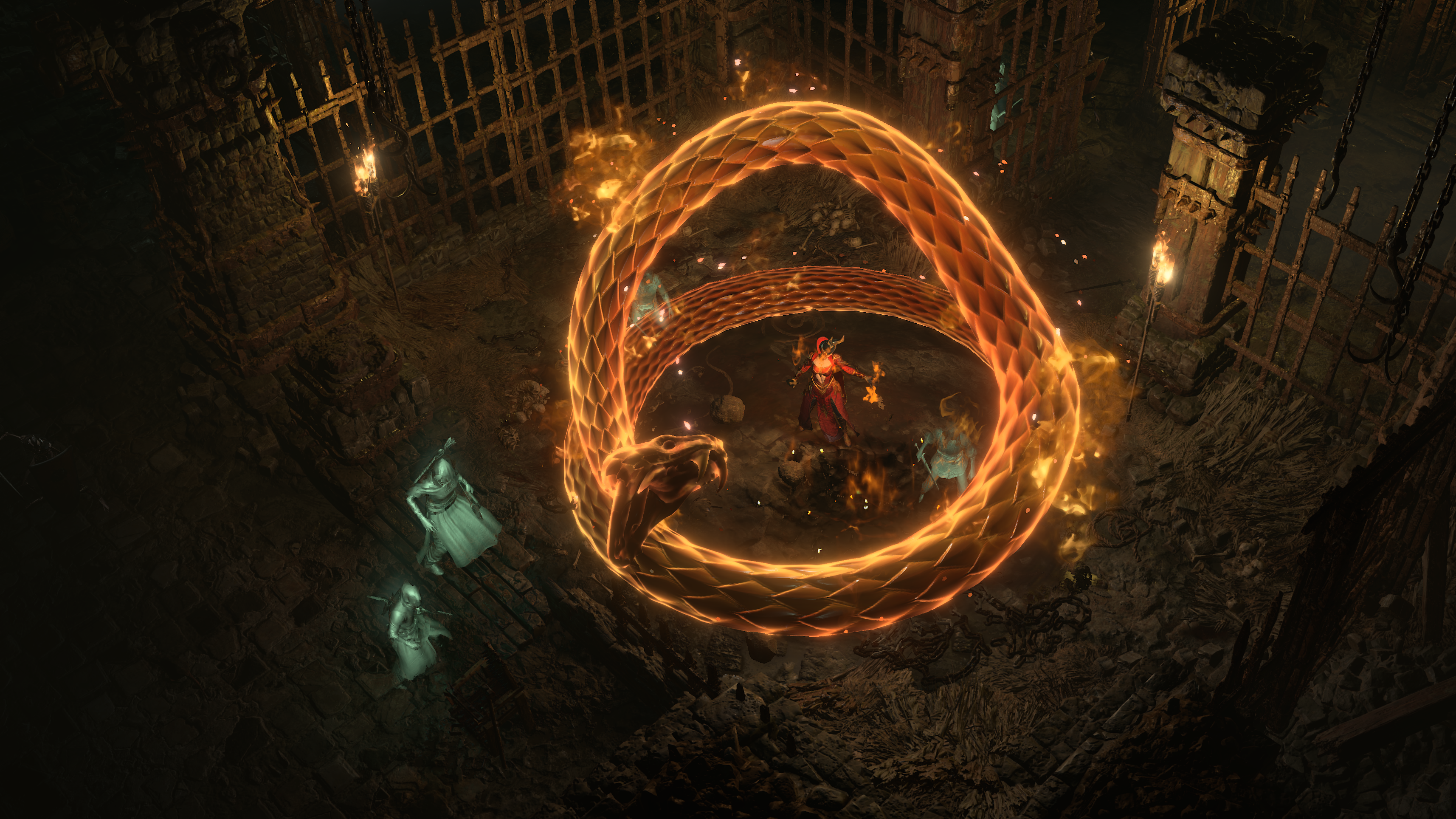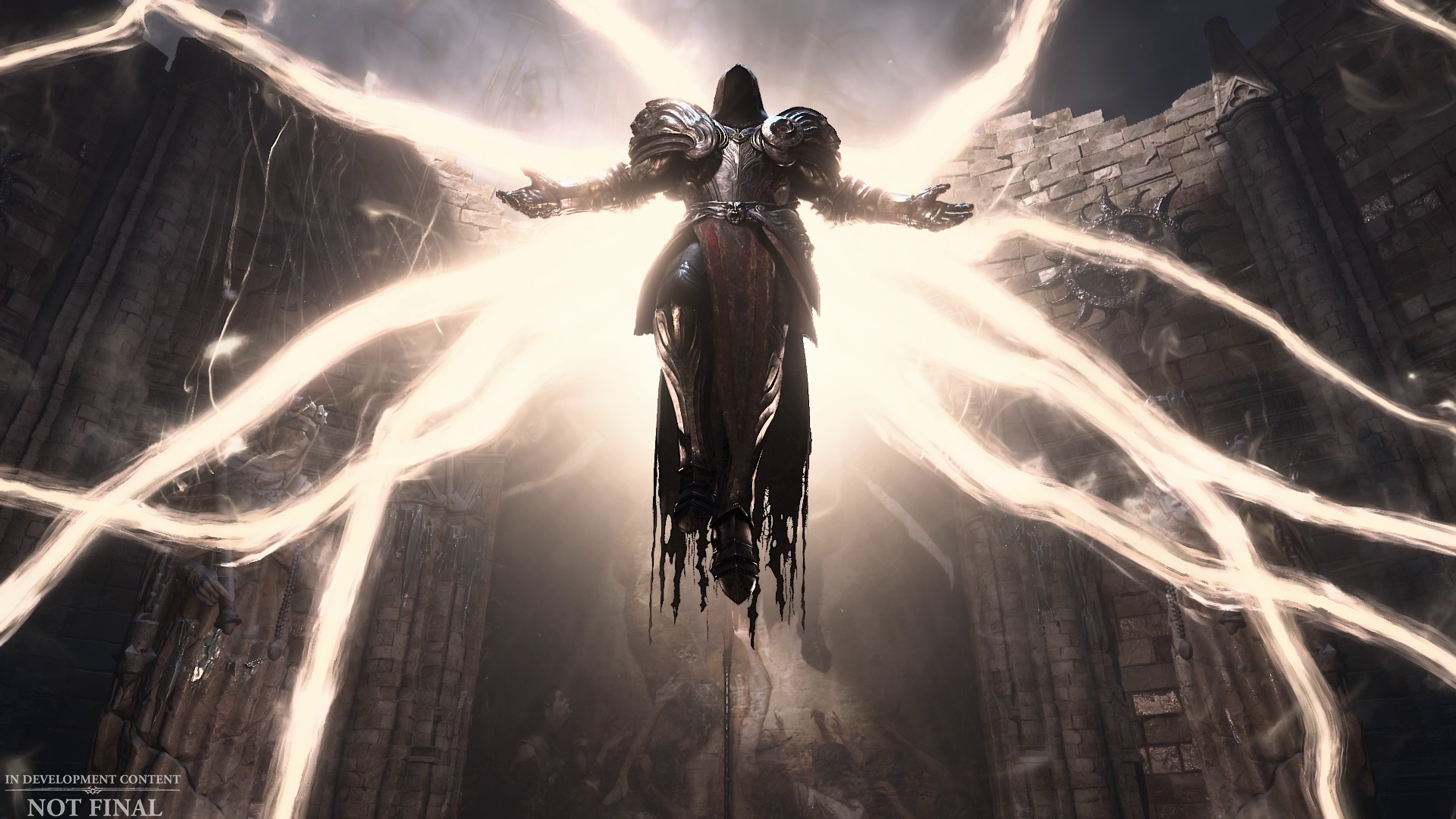
In true Blizzard fashion, Diablo 4 kicks off with a lavishly-rendered CG cutscene. As the camera swoops into re-introducing the satanic world of Sanctuary, we join a band of brigands fighting for their life.
Surrounded by an army of the undead, these dagger-clutching tomb raiders desperately slice at their palms, spilling pools of blood into a stone circle as the horde approaches. While the shrieking ghouls and clanking skeletons shuffle ever closer, the band's bloodletting grows desperate – their veins and voices willing the nearby door to open. Just as their fate looks sealed, the vault door opens. Sprinting for their lives, the brigands leap to safety, sealing off the undead and one of their own with them, the unlucky thief’s blood-curdling screams muted by the slamming of stone.
It’s a surprisingly stark opening, and one made all the more grim just minutes later, as the surviving bandits have the blood sucked out of them, a sea of crimson summoning forth Diablo 4’s big bad: Lilith. It’s a far cry from the sanitized PG-13 tone I’ve come to expect from Blizzard, with this surprisingly tense and bloodstained introduction setting the tone for the gory horror to come.
Bloody roots

“When you look at pop culture today it shows that you can be mainstream and dark,” Rod Fergusson, General Manager of the Diablo Franchise, tells me. “Look at Game of Thrones, or Walking Dead, or even Squid Game – they have an edge to them and are still mainstream, so it felt like this was the right time to go back to the dark roots of Diablo.”
When people ask what the elevator pitch is for Diablo 4, I always say, it's the dark tone of Diablo 1, the progression and permanence of Diablo 2, and the visceral combat of Diablo 3.
Rod Fergusson - GM of Diablo Franchise
Throughout my 10 hours with the beta, I’m struck by just how violent and relentlessly bleak Diablo’s loot-littered Sanctuary has become. With gore and guts just as integral to Diablo 4 as grind and gear, after the family-friendly Diablo 3, Fergusson reveals that 4 is Blizzard hitting the reset button.
“[Diablo 4] is a homage to what Diablo used to be,” he explains. “When people ask what the elevator pitch is for Diablo 4, I always say, it's the dark tone of Diablo 1, the progression and permanence of Diablo 2, and the visceral combat of Diablo 3. Internally we were using this phrase 'return to darkness’; and that was really the idea – innovating with Diablo 4’s gameplay but going back to what Diablo was as a franchise [tonally].”
Sanctuary is also a scarily large place to explore, with Diablo 4 delivering the series' first true open world. While roaming large maps is hardly novel in video games, Diablo 4’s use of an open world hiding a lobby feels innovative. Where the last game saw players navigating servers via a series of menus, here everything happens in the background while exploring Diablo’s dark and demon-infested world.
Sign up for breaking news, reviews, opinion, top tech deals, and more.
“In Diablo 3, even when you're in the game, you're sitting in a menu,” Diablo 4’s Game Director, Joe Shely, explains. “You're in the UI deciding the difficulty, [deciding] to play on this server with these other people – in Diablo 4 all that takes place in the game world.”
“You're sitting in the middle of [the world], snow coming down... and you want to change the difficulty. Well, there's a statue in the middle of town and you can run over to it and switch your world tier from adventure to veteran. I think it's so cool that we were able to build this expansive world of Sanctuary out of all the core Diablo gameplay and have it [happen] in a real place that you can run and ride across.”
The root of all evil

It wasn’t just the third entry’s lackluster story and PG-13 tone that upset some fans. Thanks to a disastrous online launch and broken ‘pay to powerup’ microtransactions, Diablo 3’s online marketplace quickly resulted in a mess of a game. Unsurprisingly, this time around, Blizzard is keen to stress that Diablo 4’s microtransactions are solely limited to cosmetic items – ensuring that the only advantage money grants you is prettier armor.
“There's no pay for power,” Shely states, for what feels like the fourth time across our interview and presentation section. Still, it seems as though this time around even the addition of purchasable cosmetics will benefit the overall Diablo experience. With new seasons coming to the game every three months, and regular story expansions down the line, Shely says that this additional content will be funded by money made from any cosmetic purchases and season pass sales.
It all feeds into what seems to be a newfound focus for Blizzard - really doubling down on Diablo’s sense of adventure. While going after Lillith is the backbone of Diablo 4’s cult-filled campaign, in a nod to its open-world peers, this newly expansive Sanctuary will be also populated with many smaller, more grounded stories.
“It’s about providing a nonlinear story and the player with whatever they want to do” says Ferguson.
“Our story is structured in such a way that you can decide how you want to approach it and what order you play everything in,” adds Shely. “You can play the three acts in any order, which means that if you make another character and you choose to play the campaign again, you even have the ability with new characters to skip the campaign.”
While the core loop of battling, grinding for XP, and upgrading gear is still the beating heart of the Diablo experience, for the fourth outing, the team states the real adventure is found off the beaten path. During my time with the beta, I happened upon several villagers offering your bog-standard ‘Kill X’ side quests, but didn’t manage to encounter any of the touching tales or hidden Elite Monsters the team suggested.
Unholy unions

While Diablo 4’s atmospheric open world results in a surprisingly fun solo adventure, this is of course, a series built for multiplayer. Featuring four players online and two players local co-op, outside of specific events where the wider world beckons, it’s up to the player to invite other adventurers into their single-player saga.
The game architecture adjusts the number of players that are in an area, based on the type of activity that is taking place there. You can be adventuring…fighting monsters, and then you can encounter these events where someone needs help, or a demonic ritual is taking place.
Joe Shely - Diablo 4 Game Director
“In the campaign, you'll only see people if you invite them directly to your party,” Shely explains. Outside of the more solitary campaign, however, Sanctuary will be an extremely social place to be.
“We have events in the world too, “ Shely continues. “And the way that works is the game architecture adjusts the number of players that are in an area, based on the type of activity that is taking place there. You can be adventuring…fighting monsters, and then you can encounter these events where someone needs help, or a demonic ritual is taking place.
"What's really cool about that, is that the game servers are essentially saying: ‘Okay, well, you know, these two people are in the world doing the same thing – let's put them together!’ So you're not spending time looking for other people who want to do the same thing – the game naturally does that.”
In Diablo 3, your server selection would take you to a town – one of the world’s social hubs. Now you can run or gallop to each hub and say hi whenever you please.
“As you're running around in the town, you'll see other players quite frequently, because our towns are our social hubs,” Shely explains. “ So there's lots of the game that provides opportunities to interact with other people and form groups.”
In typical Diablo fashion, you’ll need to put in the work in order to gain access to the higher difficulty levels. Known as World Tiers, gaining access to higher ranks requires you to earn your status – defeating brutally challenging behemoths called World Bosses. These raid-like enemies will also be a point where players come together and team up to topple the threat.
Shely also subtly reveals that this element of seamless multiplayer has also been applied to a fan-favorite piece of the Diablo experience that Blizzard has hardly talked about: Four’s PVP.
“The same thing applies to our PvP which we're not really talking about yet.” Shely teases. “But [the PVP] is such a great example of the game world actually putting people together. In PvP areas, you can travel to particular areas of the world where you can be attacked by other players. You can just go there and there are other people who are engaged in fighting monsters, fighting other players, and it's a really fun time.”
The devil and the crossroads

With Diablo 4 now scheduled for release on June 6, 2023, it feels like the long journey of development has finally come to an end for Blizzard. Initially revealed in 2019, it’s been a long wait for the series’ fourqeul – and last year’s leaked footage dampened the game’s big post-E3 push.
“Leaks are always unfortunate and I think they kind of steal some joy from players,” reflects Fergusson on last September’s playtest leaks. “It undermines the hard work of the team and you lose opportunities to surprise and delight players, so it's always disappointing. But the team is dedicated to the game and everybody loves what we're working on – so ultimately, [the leaks] haven't really influenced or impacted our morale.”